There are at least four main types of competitive pigeon sport:

The homing pigeon, also called the mail pigeon or messenger pigeon, is a variety of domestic pigeons derived from the wild rock dove, selectively bred for its ability to find its way home over extremely long distances. The rock dove has an innate homing ability, meaning that it will generally return to its nest using magnetoreception. Flights as long as 1,800 km have been recorded by birds in competitive pigeon racing. Their average flying speed over moderate 965 km distances is around 97 km/h and speeds of up to 160 km/h have been observed in top racers for short distances.
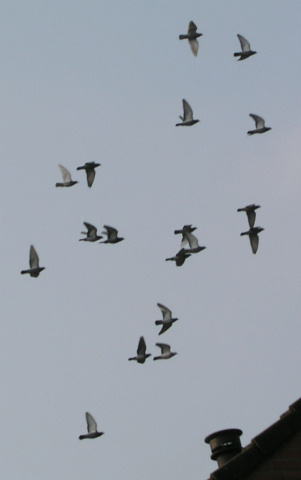
Pigeon racing is the sport of releasing specially trained homing pigeons, which then return to their homes over a carefully measured distance. The time it takes the animal to cover the specified distance is measured and the bird's rate of travel is calculated and compared with all of the other pigeons in the race to determine which animal returned at the highest speed.
Fancy pigeon refers to any breed of domestic pigeon, which is a domesticated form of the wild rock dove. They are bred by pigeon fanciers for various traits relating to size, shape, color, and behavior, and often exhibited at pigeon shows, fairs and other livestock exhibits.

The Fantail is a popular breed of fancy pigeon. It is characterised by a fan-shaped tail composed of 30 to 40 feathers, abnormally more than most members of the dove and pigeon family, which usually have 12 to 14 tail feathers. The breed is thought to have originated in Pakistan, India, China, Japan or Spain. There are several subvarieties, such as the English Fantail, the Indian Fantail, and the Thai Fantail. Charles Darwin used it as one of the examples in the first chapter of his book On the Origin of Species. He believed it was a descendant of the rock dove.
The tippler is a breed of domestic pigeon bred to participate in endurance competitions. Flying results of up to 22 hours (non-stop) have been reported.
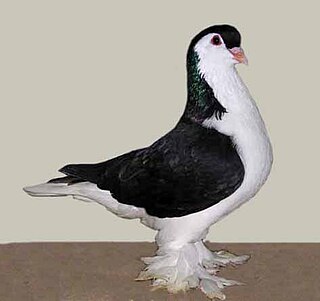
The Lahore is a breed of fancy pigeon known for its impressive size and gentle nature. Lahores, along with other varieties of domesticated pigeons, are all descendants of the rock pigeon.

Pigeon keeping or pigeon fancying is the art and science of breeding domestic pigeons. People have practiced pigeon keeping for at least 5,000 years and in almost every part of the world. In that time, humans have substantially altered the morphology and the behaviour of the domesticated descendants of the rock dove to suit their needs for food, aesthetic satisfaction and entertainment.

The Pouter pigeons are domesticated varieties of the rock dove, Columba livia, characterized by a very large, inflatable crop. They are kept as ornamental or fancy breeds, valued for their unusual appearance. There are many varieties of pouter with little in common except for the nature of the crop. The origin of the breed group is unknown, but Pouters have been bred in Europe for at least 400 years.

The Birmingham Roller is a breed of domesticated roller pigeon that originated in Birmingham, England. They were developed via selective breeding, for their ability to do rapid backward somersaults while flying.

The Komorn Tumbler is a breed of fancy pigeon developed over many years of selective breeding. The breed has American and European varieties that are recognized as separate breeds at shows with classes catering for American Komorner Tumblers and European Komorner Tumblers. Originally bred for acrobatic flying as a tumbler pigeon, Komorners are seldom free-flown today, and exist only for exhibition in pigeon shows.

The Indian Fantail is a breed of fancy pigeon developed over many years of selective breeding. Indian Fantails, along with other varieties of domesticated pigeons are all descendants of the rock dove.

The Danzig Highflyer is a breed of fancy pigeon developed over many years of selective breeding. Danzig Highflyers, along with other varieties of domesticated pigeons, are all descendants from the rock pigeon. There are two major variates of the Danzig Highflyer: ones that are bred for show, and others as pets for flying.
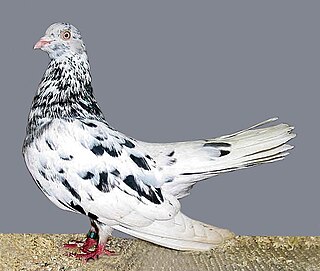
The Oriental Roller is a breed of fancy pigeon developed over many years of selective breeding. Oriental Rollers, along with all other varieties of domesticated pigeons, are descended from the rock pigeon.

Tumbler pigeons are varieties of domesticated pigeons that are descendants of the rock dove that have been selected for their ability to tumble or roll over backwards in flight.
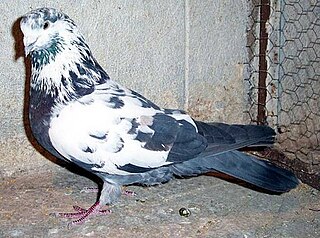
The Iranian Highflying Tumbler pigeon also known as "Persian Highflying Tumbler" in Europe and "Tehrani" in Iran is a breed of domestic pigeon bred in Iran for performance and endurance flying competitions. They fly at a very high altitude and at times out of sight. The tumbling is nothing like a Birmingham Roller, individual flips, occasionally hovering before it does the flip.

The Norfolk Grey is a utility breed of chicken that originated near the city of Norwich, in Norfolk, England, in around 1910. The breed was originally created by Frederick W Myhill of Hethel, Wymondham under the name Black Maria. It is a rare breed which is currently considered to be at risk by the Rare Breeds Survival Trust.

Utility pigeons are domesticated pigeons bred to be a source of meat called squab. Squabs have been used as a food in many nations for centuries. They were bred to breed and grow quickly. Because they are bred for squab production, conformation to a show standard is usually deemed unimportant.
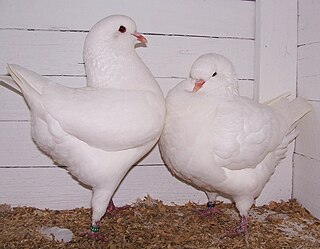
The King pigeon is a breed of pigeon developed over many years of selective breeding primarily as a utility breed. Kings along with other varieties of domesticated pigeons are all descendants from the rock dove.
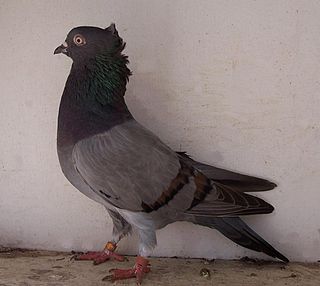
The Serbian Highflyer is a breed of domestic pigeon that is bred for endurance flying. The breed is characterized by long circle flights up to 15 hours. It can fly as high as 1,500 metres (4,900 ft). There are about 20,000 fanciers of this breed in Serbia.
















